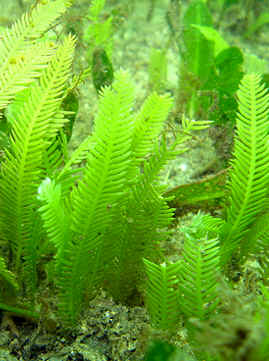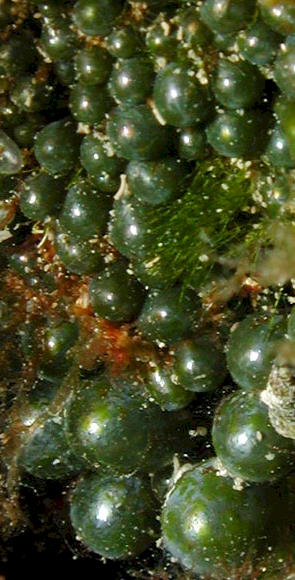|
 Maintenance
of marine planted aquarium is a necessary chore for long
term success. Like most
aquaria, if the aquarium is neglected the inhabitants will likely
suffer and various micro algae will soon invade, turning a beautiful
aquascape into a container of pea soup. Unlike coral
dominated reef aquaria, marine plants produce large amounts
of organic material, which in turn can form large deposits
of nutrient rich substrate or detritus. While some amount of
organic material can be beneficial in storing nutrients and
even necessary in sea grass aquaria, the accumulation will
almost certainly feed unwanted growth of nuisance micro
algae. As
mentioned previously, water changes are the single most
important measure to maintain a healthy, balanced ecosystem.
Depending on the size of the aquarium, a weekly water change
of about 25% is enough to continually maintain a planted
aquarium. In large systems with high evaporation rates,
biweekly water changes are normally just as effective. Maintenance
of marine planted aquarium is a necessary chore for long
term success. Like most
aquaria, if the aquarium is neglected the inhabitants will likely
suffer and various micro algae will soon invade, turning a beautiful
aquascape into a container of pea soup. Unlike coral
dominated reef aquaria, marine plants produce large amounts
of organic material, which in turn can form large deposits
of nutrient rich substrate or detritus. While some amount of
organic material can be beneficial in storing nutrients and
even necessary in sea grass aquaria, the accumulation will
almost certainly feed unwanted growth of nuisance micro
algae. As
mentioned previously, water changes are the single most
important measure to maintain a healthy, balanced ecosystem.
Depending on the size of the aquarium, a weekly water change
of about 25% is enough to continually maintain a planted
aquarium. In large systems with high evaporation rates,
biweekly water changes are normally just as effective.
 Cleaning
sediment and organic material from the aquarium substrate is
a controversial subject for some aquarists. It can be done
by natural means or by manual removal. It is not recommended
to disturb the sand bed too much, as the sediment released
can cover the plants, rocks and other inhabitants. There
are many beneficial invertebrates that can be added to a
marine planted aquarium to aid in the cleaning and removal
of organic material. An important aspect is to not
overstock, as the "clean-up crew" will become
counterproductive, often preying on each other. Various
worms, copepods, amphipods, sea cucumbers, reef safe hermit
crabs and snails will provide a natural way of keeping the
substrate aerated, healthy and clean. Cleaning
sediment and organic material from the aquarium substrate is
a controversial subject for some aquarists. It can be done
by natural means or by manual removal. It is not recommended
to disturb the sand bed too much, as the sediment released
can cover the plants, rocks and other inhabitants. There
are many beneficial invertebrates that can be added to a
marine planted aquarium to aid in the cleaning and removal
of organic material. An important aspect is to not
overstock, as the "clean-up crew" will become
counterproductive, often preying on each other. Various
worms, copepods, amphipods, sea cucumbers, reef safe hermit
crabs and snails will provide a natural way of keeping the
substrate aerated, healthy and clean.
Many
aquarists employ a small pump to create "miniature
storms" within the tank so that the mechanical filter
can extract most of the floating particles and also provide
food for some invertebrates. This can be helpful in some
aquariums, but densely planted aquariums often will suffer
as the sediment completely covers the plants. Gently vacuuming
the top layer of a the substrate is popular with
freshwater planted aquarists, and can be done with care in
marine planted tanks. This does not work very well with fine
sand substrates however, and can remove beneficial fauna
from the tank.
 Besides
maintaining the overall water quality, most of the
maintenance in a planted aquarium is concentrated on the
plants themselves. In a healthy environment, most marine
plants will grow at a very fast rate. If left unattended,
they will reach a critical biomass and slowly
die or outcompete another species for available light and
nutrients. Besides
maintaining the overall water quality, most of the
maintenance in a planted aquarium is concentrated on the
plants themselves. In a healthy environment, most marine
plants will grow at a very fast rate. If left unattended,
they will reach a critical biomass and slowly
die or outcompete another species for available light and
nutrients.
Caulerpa
are among the fastest growing macro algae and will need regular
pruning and control. Fish may be employed to do the task, but will
often devour entire colonies in a short time. Simply removing
plant material is the best method of control. With Caulerpa,
simply divide the colony into even parts by pinching the rhizome between
your fingers or by using surgical style scissors. Most species will
form a ball of mucus at the rhizome and/or secrete a small amount
of organic chemical, but this will heal quickly.
Red
macro algae grow much slower than green, but several species such
as Botryocladia and Halymenia can overgrow an aquarium. Red algae
can be cut or torn at any location without harming the plant. If
a holdfast is present, growth should be removed from the top
portion, as this attachment takes time to develop. Regular
trimming of clear or old growth is recommended as some larger
species will reach a critical biomass as nutrients are exhausted
in the aquarium. Some species will release a chemical when cut,
but the effect on other species is minimal.
For
the most part, brown macro algae are very slow growing and need
very little maintenance. Sargassum can grow quite large and may need
to be trimmed occasionally to allow light to reach the bottom of
the aquarium and other species.
|